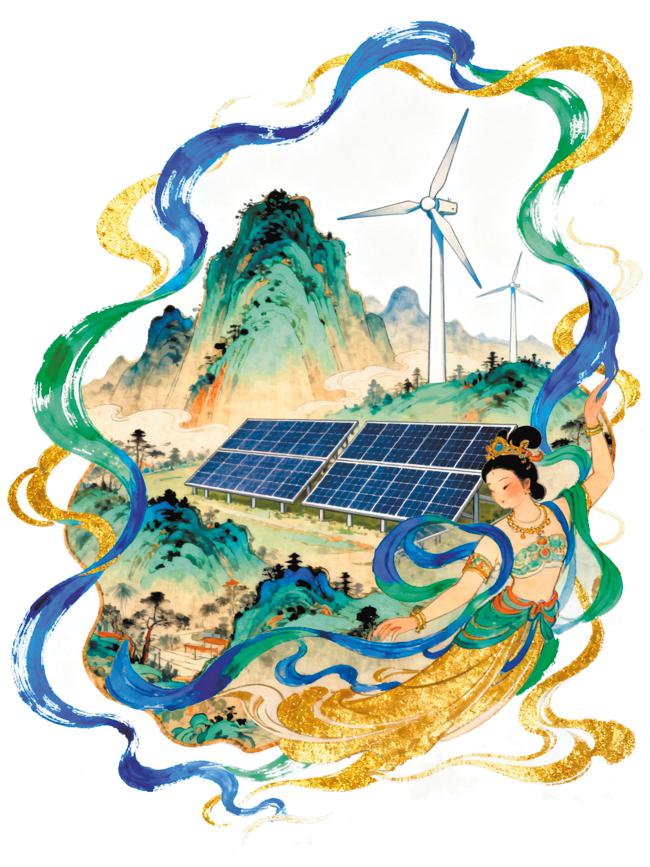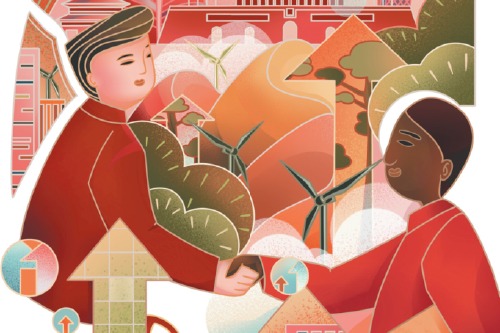Walk the talk
With the US retreating from its climate responsibilities, China is stepping up to lead the way toward a sustainable future


In recent years, China has been at the forefront of the world's green transformation. While the United States has faltered, China has charted a bold path that combines technological ingenuity, large-scale deployment and international cooperation. Its achievements, both at home and abroad, make clear that China has not only accepted the challenge of building a sustainable future within China but is defining global leadership in the era of climate change.
Today, as the US retreats further from responsibility, China's role is magnified. The coming years will see China not only sustain its current pace of innovation and deployment but also expand its global network of partnerships and leadership in the service of building a community with a shared future for humanity.
China's green revolution began with the recognition that "lucid waters and lush mountains are invaluable assets". Over the past two decades, this philosophy has guided policies that have transformed China's landscapes, energy systems and industries. China has implemented bold projects for the protection and restoration of its mountains, rivers, forests, farmlands, lakes, grasslands and deserts. According to widely reported official data, these initiatives now cover more than 120 million mu (8 million hectares) and have restored about 1,780 kilometers of coastline. China's forests and grasslands are now reportedly absorbing more than 1.2 billion metric tons of carbon dioxide annually, an extraordinary achievement of Earth-protecting significance.
At the same time, China has revolutionized renewable energy. In the past decade, the costs of wind power have dropped by more than 60 percent and solar power by around 80 percent, largely due to Chinese manufacturing and innovation. China is now the world's leading producer of solar modules, wind turbines and electric vehicles. Its investments in grid modernization, ultra-high-voltage transmission and energy storage make it uniquely capable of deploying clean energy at scale and enabling other countries to do so as well. In every dimension of the energy transition — from renewables to smart grids to electric mobility — China has shifted the trajectory of global energy systems.
China's leadership is of course not confined to its borders. Through cooperation with other emerging and developing countries, China supports these nations, including highly vulnerable small island states, least developed countries and low-income nations in Africa, in their efforts to scale up their energy systems with sustainable green technologies. These investments underscore China's dual role as both an innovator and a global partner, helping other nations advance toward sustainable futures.
Perhaps most striking is China's role in scaling technologies that the rest of the world now looks to for its own energy future. From fourth-generation nuclear power technology to clean ocean shipping, hydrogen production, environmentally safe mining, advanced robotics and global energy interconnection, China has the industrial capacity to help support the global energy and land use transition.
Decades ago, the US could claim to lead on global climate and environmental issues, yet since the 1990s it has increasingly retreated from this responsibility. Its domestic politics have polarized climate policy; its financial commitments to global initiatives have dwindled; and its global credibility has eroded. Indeed, President Donald Trump proclaimed that human-induced climate change is a "con job" and urged countries to scale up their use of fossil fuels at the United Nations in September. This flagrant irresponsibility toward science, climate-afflicted regions and future generations reflects very poorly on the US role in the world.
With this abdication by the US, China's leadership has become even more vital. Yes, Washington will eventually return to the truth and its responsibilities, but the world will certainly now look to China for global leadership and creative partnerships to save the planet from the scourges of environmental degradation.
Looking toward the next quarter-century, China can take its green global leadership to new heights with three measures.
First, expanding the green Belt and Road Initiative. China can scale up its world-renowned Belt and Road Initiative, with a focus on investments in zero-carbon energy, reforestation and sustainable agriculture. China will thereby create win-win partnerships that address climate change and infrastructure development in partner countries while also generating exports, economic growth and jobs in China's own economy. An expanded green BRI can set the global benchmark for sustainable development financing and demonstrate that large-scale infrastructure investments can be both profitable and environmentally sound.
Second, leading the Paris Agreement implementation. With the US abandoning its global commitments, China can assume global leadership in partnership with the European Union to implement the Paris Agreement. Through its diplomatic, technological and financial leadership, China can become the anchor of a coalition committed to keeping global warming well below 2 C and striving for 1.5 C. Such co-leadership with the EU would ensure that international climate governance remains robust and effective despite the failures of other powers.
Third, hosting a UN campus on sustainable energy and land use. China can host a major UN campus in Beijing, dedicated to the world cause of sustainable energy and land use. At present, the UN's major campuses are in New York, Vienna, Geneva and Nairobi. Establishing a major UN campus in Beijing would greatly bolster the UN system and reflect China's pre-eminent global role in technology, finance and governance. The UN campus would provide an invaluable hub for training, research and international cooperation. It would symbolize China's commitment not only to its own green future but to a shared global destiny.
The next 20 years may well determine the planet's fate. Humanity can succeed in taking decisive steps to stabilize the climate and preserve biodiversity, or else may hit "tipping points" that lead to drastically rising sea levels, collapsing ecosystems and widespread suffering. China has shown that decisive action toward sustainable development is possible. China has built vast, cutting-edge industrial capacity that now serves the world. By greening the Belt and Road, accelerating its net zero target and helping lead the implementation of the Paris Agreement, China can ensure that the coming quarter-century is one of renewal and shared prosperity.
The author is a professor at Columbia University and the director of the Center for Sustainable Development at Columbia University. The author contributed this article to China Watch, a think tank powered by China Daily.
The views do not necessarily reflect those of China Daily.
Contact the editor at editor@chinawatch.cn.


































